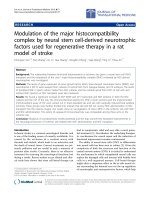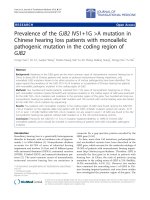Báo cáo hóa học: " Uniqueness of the potential function for the vectorial Sturm-Liouville equation on a finite interval" doc
Bạn đang xem bản rút gọn của tài liệu. Xem và tải ngay bản đầy đủ của tài liệu tại đây (264.01 KB, 8 trang )
RESEARC H Open Access
Uniqueness of the potential function for the
vectorial Sturm-Liouville equation on a finite
interval
Tsorng-Hwa Chang
1,2
and Chung-Tsun Shieh
1*
* Correspondence: ctshieh@mail.
tku.edu.tw
1
Department of Mathematics,
Tamkang University, No.151,
Yingzhuan Rd., Danshui Dist., New
Taipei City 25137, Taiwan, PR China
Full list of author information is
available at the end of the article
Abstract
In this paper, the vectorial Sturm-Liouville operator
L
Q
= −
d
2
dx
2
+ Q(x
)
is conside red,
where Q(x) is an integrable m × m matrix-valued function defined on the interval
[0,π] The authors prove that m
2
+1 characteristic functions can determine the
potential function of a vectorial Sturm-Liouville operator uniquely. In particular, if Q(x)
is real symmetric, then
m(m +1)
2
+
1
characteristic functions can determine the
potential function uniquely. Moreover, if only the spectral data of self-adjoint
problems are considered, then m
2
+ 1 spectral data can determine Q(x) uniquely.
Keywords: Inverse spectral problems, Sturm-Liouville equation
1. Introduction
The study on inverse spectral problems for th e vectorial Sturm-Liouville differential
equation
y
+
(
λI
m
− Q
(
x
))
y =0, 0< x <π
,
(1:1)
on a finite interv al is devoted to deter mine the potential matrix Q(x) from the spec-
tral data of (1.1) with boundary conditions
U
(
y
)
:=
y
(
0
)
− h
y
(
0
)
=0, V
(
y
)
:=
y
(
π
)
+ H
y
(
π
)
=0
,
(1:2)
where l is the spectral parameter,
h =[h
ij
]
i,
j
=1,m
and
H =[H
ij
]
i,
j
=1,m
are in
M
n
(
C
)
and
Q(x)=[Q
ij
(x)]
i,
j
=1,m
is an integrable matrix-valued function. We use L
m
= L(Q, h, H)
to denote the boundary problem (1.1)-(1.2). For the case m = 1, (1.1)-(1.2) is a scalar
Sturm-Liouville equation. The scalar Sturm-Liouville equation often arises from some
physical problems, for example, vibration of a string, quantum m echanics and geophy-
sics. Numerous research results for this case have been established by renowned math-
ematicians, notably Borg, Gelfand, Hochstadt, Krein, Levinson, Levitan, Marchenko,
Gesztesy, Simon and their coauthors and followers (see [1-9] and references therein).
For the case m ≥ 2, some interesting results had been obtained (see [10-20]). In parti-
cular, for m =2andQ(x) is a two-by-two real s ymme tric matrix- valu ed smooth func-
tions defined in the interval [0, π] Shen [18] showed that five spectral data can
Chang and Shieh Boundary Value Problems 2011, 2011:40
/>© 2011 Chang and Shieh; licensee Springer. This is an Open Access art icle distributed under the terms of the Creative Commons
Attribution License ( .0), which permits unrestricted use, distribution, and reproduction in
any medium, provid ed the original work is properly cited.
determine Q(x) uniquely. More precisely speaking, he considered the inverse spectral
problems of the vectorial Sturm-Liouville equation:
y
+
(
λI
2
− Q
2
(
x
))
y
(
x
)
=0, 0< x <π
,
(1:3)
where Q
2
(x) is a real symmetric matrix-valued function defined in the interval [0, π].
Let s
D
(Q) denotes the Dirichlet spectrum of (1.3), s
ND
(Q) the Neumann-Dirichlet
spectrum of (1.3) and s
j
(Q) the spectrum of (1.3) with boundary condition
y
(0) − B
j
y(0) =
y(π )=
0
,
(1:4)
for j = 1, 2, 3, where
B
j
=
α
j
β
j
β
j
γ
j
is a real symmetric matrix and {(a
j
, b
j
, g
j
,), j = 1, 2, 3} is linearly independent over ℝ.
Then
Theorem 1.1 ([18], Theorem 4.1). Let Q
2
(x) and
Q
2
(
x
)
be two continuous two-by-two
real symmetric matrix-valued functions defined on [0, π ]. Suppose that
σ
ND
(
Q
)
= σ
ND
(
Q
)
σ
ND
(
Q
)
= σ
ND
(
Q
)
and
σ
j
(Q)=σ
j
(
Q
)
for j = 1, 2, 3, then
Q
(
x
)
=
Q
(
x
)
on [0, π].
The purpose of this paper is to generalize the above theorem for the case m ≥ 3. The
idea we use is the Weyl’s matrix for matrix-valued Sturm-Liouville equation
Y
+
(
λI
m
− Q
(
x
))
Y =0, 0< x <π
.
(1:5)
Some uniqueness theorems for vectorial Sturm-Liouville equation are obtained in the
last section.
2. Main Results
Let
C(x, λ)=[C
ij
(x, λ)]
i,
j
=1,m
and
S(x, λ)=[S
ij
(x, λ)]
i,
j
=1,m
be two solutions of equation
(1.5) which satisfy the initial conditions
C(0, λ)=S
(0, λ)=I
m
,
C
(
0, λ
)
= S
(
0, λ
)
=0
m
,
where 0
m
is the m × m zero matrix,
I
m
=[δ
ij
]
i,
j
=1,m
is the m × m identity matrix and
δ
ij
is the Kronecker symbol. For given complex-valued matrices h and H, we denote
ϕ(x, λ)=
ϕ
ij
(x, λ)
i,j=1,m
and (x, λ)=
ij
(x, λ)
i,j=1,m
be two solutions of equation (1.5) so that (x, l)=C(x, l)+S(x, l)h and
(
x, λ
)
= S
(
x, λ
)
+ ϕ
(
x, λ
)
M
(
λ
)
which satisfy the boundary conditions
U( )=
(0) − h(0) = I
m
,
V()=
(π)+H(π)=0
m
.
(2:1)
Then,
M
(
λ
)
=
(
0, λ
)
. The matrix
M(λ)=[M
ij
(λ)]
i,
j
=1,m
is c alled the Weyl m atrix
for L
m
(Q, h, H). In 2006, Yurko proved that:
Theorem 2.1 ([20], Theorem 1). Let
M
(
λ
)
and
M
(
λ
)
denote Weyl matrices of the
problems L
m
(Q, h, H) and
L
m
(
Q,
˜
h,
H
)
separately. S uppose
M
(
λ
)
=
M
(
λ
)
, then
h
=
˜
h
,
h
=
˜
h
and
H
=
H
.
Chang and Shieh Boundary Value Problems 2011, 2011:40
/>Page 2 of 8
Also note that from [20], we have
(
x, λ
)
= S
(
x, λ
)
+ ϕ
(
x, λ
)
M
(
λ
)
= ψ
(
x, λ
)(
U
(
ψ
))
−
1
,
(2:2)
M
(
λ
)
= −
(
V
(
ϕ
))
−1
V
(
S
)
= ψ
(
0, λ
)(
U
(
ψ
))
−
1
(2:3)
where
ψ(x, λ)=[ψ
ij
(x, λ)]
i,
j
=1,m
is a matrix solution of equation (1.5) associated with
the conditions ψ(π, l)=I
m
and ψ’ (π, l)=-H. It is not difficult to see that both F (x, l)
and
M(
λ
)
are meromorphic in l and the poles of
M(
λ
)
are coincided with the eigenva-
lues of L
m
(Q, h, H). Moreover, we have
M(λ)=−(V(ϕ))
−1
V(S)=−
Adj(ϕ
(π,λ)+Hϕ(π,λ))
det
(
ϕ
(
π,λ
)
+ Hϕ
(
π,λ
))
(S
(π,λ)+HS(π , λ))
,
where Adj(A) denotes the adjoint matrix of A and det(A) denotes the determinant o f
A. In the remaining of this section , we shall prove some uniqueness theorems for vec-
torial Sturm-Liouville equations. Let
B(i, j)=
b
rs
r
,
s=1
,
m
,
b
rs
=
0, (r, s) =(i, j),
1, (r, s)=(i, j),
1 ≤ i, j ≤ m
,
and B(0, 0) = 0
m
The characteristic function for this boundary value problem L
m
(Q, h +
B(i, j), H)is
i
j
(λ)=det(V(ϕ + SB(i, j))), 1 ≤ i, j ≤ m or (i, j)=(0,0)
.
(2:4)
The first problem we want to study is as following:
Problem 1. How many Δ
ij
(l) can uni quely determine Q, h and H? where (i, j) = (0,
0) or 1 ≤ i, j ≤ m
To find the solution of Problem 1, we start with the following lemma
Lemma 2.2. Let B(i, j)=[b
rs
]
m×m
and Δ
ij
be defined as above. Then
ij
(λ)=
00
(λ)+det(Augment[ϕ
1
(π,λ)+Hϕ
1
(π,λ), ,
(jth column)
S
i
(π,λ)+HS
i
(π,λ), , ϕ
m
(π,λ)+Hϕ
m
(π,λ)])
,
where
k
(π, l) is the k th column of (π, l) and S
k
(π, l) the kth colum n of S (π, l)
for k = 1, 2, 3, , m.
Proof. Let
Y(x, λ)=[C(x, λ)+S(x, λ)(h + B(i, j))]
=[(C(x, λ)+S(x, λ)h)+S(x, λ)B(i, j)
]
=[ϕ
(
x, λ
)
+ S
(
x, λ
)
B
(
i, j
)
]
Then
ij
(λ)=det(Y
(π,λ)+HY(π,λ))
=det((ϕ
(π,λ)+Hϕ(π,λ)) + (S
(π,λ)+HS(π , λ)B(i, j))
=det((ϕ
(π,λ)+Hϕ(π,λ)) +
(jth column)
[0, S
i
(π,λ)+HS
i
(π,λ)0])
=det(ϕ
(π,λ)+Hϕ(π,λ)) + det(ϕ
1
(π,λ)+Hϕ
1
(π,λ),
,
(jth column)
S
i
(π,λ)+HS
i
(π,λ), , ϕ
m
(π,λ)+Hϕ
m
(π,λ))
=
00
(λ)+det(ϕ
m
(π,λ)+Hϕ
1
(π,λ), ,
(jth column)
S
i
(π,λ)+HS
i
(π,λ), , ϕ
m
(π,λ)+Hϕ
m
(π,λ)).
□
Chang and Shieh Boundary Value Problems 2011, 2011:40
/>Page 3 of 8
Next, we shall prove the first main theorem. For simplicity, if a symbol a denotes an
object re lated to L
m
(Q, h, H), then the symbol
˜
α
denotes the analogous object related
to
L
m
(
Q,
˜
h,
H
)
.
Theorem 2.3. Suppose that
i
j
(λ)=
i
j
(λ
)
for (i, j)=(0,0)or 1 ≤ i, j ≤ mthen
h
=
˜
h
,
h
=
˜
h
and
H
=
H
.
Proof. Since
0
m
=
(
π,λ
)
+ H
(
π,λ
)
and
(
x, λ
)
= S
(
x, λ
)
+ ϕ
(
x, λ
)M(
λ
),
we have that
−
(
S
(
π,λ
)
+ HS
(
π,λ
))
e
i
=
(
ϕ
(
π,λ
)
+ Hϕ
(
π,λ
))
M
(
λ
)
e
i
for each i = 1, , m, that is,
−(S
i
(π,λ)+HS
i
(π,λ)) = (ϕ
(π,λ)+Hϕ(π,λ))M
i
(λ)
.
By Crammer’s rule,
M
ji
(λ)
=
− det(ϕ
1
(π,λ)+Hϕ
1
(π,λ), ,
(jth column)
S
i
(π,λ)+HS
i
(π,λ), , ϕ
m
(π,λ)+Hϕ
m
(π,λ))
det(ϕ
(π,λ)+Hϕ(π ,λ))
=
00
(λ) −
ij
(λ)
00
(λ)
=
00
(λ) −
ij
(λ)
00
(λ)
=
M
j
i
(λ) for 1 ≤ i, j ≤ m.
Applying Theorem 2.1, we conclude that
Q
=
Q
,
h
=
˜
h
and
H
=
H
. □
Lemma 2.4. Suppose that h, H a re real symmetric matri ces and Q(x) is a real sym-
metric matrix-valuedfunction.Then,
M(
λ
)
= −V
(
ϕ
)
−1
V
(
S
)
is re al symmetric for all l
Î ℝ.
Proof. Let
U( x , λ)=
ϕ
(x, λ) S
(x, λ)
ϕ(x, λ) S(x, λ)
.
(2:5)
For l Î ℝ,
⎧
⎪
⎪
⎪
⎨
⎪
⎪
⎪
⎩
(S
∗
ϕ − S
∗
ϕ
)(x, λ)=(S
∗
ϕ − S
∗
ϕ
)(0, λ)=I
m
,
(S
∗
S − S
∗
S
)(x, λ)=(S
∗
S − S
∗
S
)(0, λ)=0
m
,
(ϕ
∗
ϕ
− ϕ
∗
ϕ)(x, λ)=(ϕ
∗
ϕ
− ϕ
∗
ϕ)(0, λ)=0
m
,
(
ϕ
∗
S
− ϕ
∗
S
)(
x, λ
)
=
(
ϕ
∗
S
− ϕ
∗
S
)(
0, λ
)
= I
m
,
This leads to
U
−1
(x, λ)=
−(S)
∗
(x, λ)(S
∗
)
(x, λ)
ϕ
∗
(x, λ) −(ϕ
∗
)
(x, λ)
.
(2:6)
Chang and Shieh Boundary Value Problems 2011, 2011:40
/>Page 4 of 8
Now let
U
2
(x, λ)=
I
m
H
0 I
m
U( x , λ)
.
Then
U
2
(1, λ)=
I
m
H
0 I
m
U(1, λ)=
V(ϕ) V(S)
ϕ(1, λ) S(1, λ)
and
U
−1
2
(1, λ)=(
I
m
H
0 I
m
U(1, λ))
−1
=
−S
∗
(1; λ)[V(S)]
∗
(ϕ)
∗
(1, λ) −[V(ϕ)]
∗
.
Since
U
(
x, λ
)
U
−1
(
x, λ
)
= I
2m
,
we have
V(
ϕ
)
[V
(
S
)
]
∗
= V
(
S
)
[V
(
ϕ
)
]
∗
,
i.e.,
M(
λ
)
= V
(
ϕ
)
−
1
V
(
S
)
is real symmetric for all l Î ℝ. □
Definition 2.1. We call L
m
(h, H, Q) a real symmetric problem if h, H are real sym-
metric matrices and Q(x) is a real symmetric matrix-valued function.
Corollary 2.5. Let L
m
(h, H, Q) and
L
(
˜
h,
˜
H,
˜
Q
)
be two real symmetric problems. Sup-
pose that
i
j
(λ)=
˜
i
j
(λ
)
for (i, j ) = (0, 0) or 1 ≤ i ≤ j ≤ m, then
h
=
˜
h
,
h
=
˜
H
and
Q
=
Q
.
Proof. For l Î ℝ. both
M(
λ
)
and
˜
M
(
λ
)
are real symmetric. Moreover,
M
ji
(λ)=
00
(λ) − ij(λ)
00
(λ)
=
˜
00
(λ) −
˜
ij(λ)
˜
00
(λ)
=
˜
M
j
i
(λ), for 1 ≤ i ≤ j ≤ m
.
Hence,
M
i
j
(λ)=
˜
M
i
j
(λ
)
for l Î ℝ and 1 ≤ i, j ≤ m. This leads to
i
j
(λ)=
˜
i
j
(λ
)
for
l Î ℝ.Weconcludethat
i
j
(λ)=
˜
i
j
(λ
)
and
M
i
j
(λ)=
˜
M
i
j
(λ
)
for lÎℂ.Thiscom-
pletes the proof. □
From now on, we let L
m
(Q, h, H) be a real symm etric problem. We would like to
know that how many spectral data can determine the problem L
m
(Q, h, H)ifwe
require all spectral data come from real symmetric problems. Denote
ij
=
e
1
, ,
(ith-column)
0
, ,
(jth-column)
0
, , e
m
,
ij
=
0, ,
(ith-column)
e
i
, ,
(ith-column)
e
j
, ,0
,
where
e
i
=
(
0, 0, ,0,
(ith-coordiante)
1
,0, ,0
)
t
.
Hence, Γ
ij
+ Γ
ij
= I
m
.LetΘ
ij
(l)bethe
characteristic function of the self-adjoint problem
y
+
(
λI
m
− Q
(
x
))
y =0, 0< x <
π
(2:7)
Chang and Shieh Boundary Value Problems 2011, 2011:40
/>Page 5 of 8
associated with some boundary conditions
ij
y
(0, λ) − (
ij
h +
ij
)y(0, λ)=0
,
y
(π,λ)+Hy(π , λ)=0,
(2:8)
then
i
j
(λ)=det[V(ϕ
1
), ,
(ith-column)
V(S
j
), ,
(jth-column)
V(S
i
), , V(ϕ
m
)]
,
where V (L
j
) d enotes the jth column of (V( L)) for a m × m matrix L. Similarly, we
denote Ω
ij
(l) the characteristic function of the real symmetric problem
L
m
(Q, h +
1
2
(B(i, j)+B(j, i)), H
)
for 1 ≤ i, j ≤ m, then
ij
(λ)=det
⎡
⎢
⎣
V(ϕ
1
), ,
(ith-column)
V(ϕ
i
)+
1
2
V(S
j
), ,
(jth-column)
V(ϕ
j
)+
1
2
V(S
i
), , V(ϕ
m
)
⎤
⎥
⎦
=det[V(ϕ
1
), , V(ϕ
i
), , V(ϕ
m
)]
+
1
2
det[V(ϕ
1
), ,
(ith-column)
V(S
j
), ,
(jth-column)
V(ϕ
j
), , V(ϕ
m
)]
+
1
2
det[V(ϕ
1
), ,
(ith-column)
V(ϕ
i
), ,
(jth-column)
V(S
i
), , V(ϕ
m
)]
+det[V(ϕ
1
), ,
(ith-column)
V(S
j
), ,
(jth-column)
V(S
i
), , V(ϕ
m
)]
(2:9)
for 1 ≤ i, j ≤ m. For simplicity, we write
00
(λ)=det[V(ϕ
1
), , V(ϕ
j
), , V(ϕ
m
)]
.
Now, we are going to focus on self-adjoint problems. For a self-adjoint problem L
m
(Q, h, H) all its eigenvalues are real and the geometric multiplicity of an eigenvalue is
equal to its algebraic multiplic ity. Moreover, if we denote {(l
i
, m
i
)}
i =1,∞
the spectr al
data of L
m
(Q, h, H)wherem
i
is the multiplicity of the eigenvalue l
i
of L
m
(Q, h, H)
then the characteristic function of L
m
(Q, h, H)is
(λ)=C
∞
i=1
(1 −
λ
λ
i
)
m
i
where C is determined by {(l
i
, m
i
)}
i =1,∞
. This means that the spectral data deter-
mined the corresponding characteristic function.
Theorem 2.6. Assuming that L
m
( Q, h, H) and
L
m
(
˜
Q,
˜
h,
˜
H
)
are two real symmetric
problems. If the conditions
(1)
i
j
(λ)=
i
j
(λ
)
for (i, j) = (0, 0) or 1 ≤ i ≤ j ≤ m,
(2)
i
j
(λ)=
i
j
(λ
)
for 1 ≤ i<j≤ m.,
are satisfied, then
h
=
˜
h
,
H
=
H
and
Q
(
x
)
=
Q
(
x
)
a.e on [0, 1].
Chang and Shieh Boundary Value Problems 2011, 2011:40
/>Page 6 of 8
Proof. Note that for any problem L
m
(Q, h, H) we have
ij
(λ)=det[V(ϕ
1
), ,
(
it
h
-co
l
umn
)
V(ϕ
i
), ,
(
jt
h
-co
l
umn
)
V(ϕ
j
)+V(S
i
), , V(ϕ
m
)]
=det[V(ϕ
1
), , V(ϕ
j
), , V(ϕ
m
)]
+det[V(ϕ
1
), ,
(ith-column)
V(ϕ
i
), ,
(jth-column)
V(S
i
), , V(ϕ
m
)]
=
00
(λ)+det[V(ϕ
1
), ,
(ith-column)
V(ϕ
i
), ,
(jth-column)
V(S
i
), , V(ϕ
m
)
]
=
00
(λ) −
00
(λ)M
j
i
(λ).
Similarly,
˜
i
j
(λ)=
˜
00
(λ) −
˜
00
(λ)
˜
M
j
i
(λ)
.
Moreover, by the assumptions and Lemma 2.4, we have M
ij
(l)=M
ji
(l) Hence,
(1) Δ
ij
(l)=Δ
ji
(l) and
˜
i
j
(λ)=
˜
j
i
(λ
)
for 1 ≤ i ≤ j ≤ m,
(2)
ii
(
λ
)
=
ii
(
λ
)
=
ii
(
λ
)
=
ii
(
λ
)
for i = 0, 1, , m,
(3)
i
j
(λ)=
i
j
(λ) −
i
j
(λ)=
i
j
(λ) −
i
j
(λ)=
i
j
(λ
)
for 1 ≤ i<j≤ m.
This implies
L
m
(
Q, h, H
)
= L
m
(
˜
Q,
˜
h,
˜
H
).
The authors want to emphas is that for n = 1, the result is classical; for n = 2, Theo-
rem 2.6 leads to Theorem 1.1. Shen also shows by pr oviding an example that 5 mini-
mal number of spectral sets can determine the potential matrix uniquely (see [18]).
The readers may think that if all Q, h and H are diagonals then L
m
(Q, h, H)isan
uncoupled system. Hence, everything for the operator L
m
(Q, h, H) can be obtained by
applying inverse spectral theory for scalar Sturm-Liouville equation. Unfortunately, it is
not true. We say L
m
(Q, h, H) diagonal if all Q, h and H are diagonals.
Corollary 2.7. Suppose L
m
(Q, h, H) and
L
m
(
Q,
˜
h,
H
)
are both diagonals. If
kk
(
λ
)
=
kk
(
λ
)
for k = 0, 1, , m, then
Q
=
Q
,
h
=
˜
h
and
H
=
H
.
Proof. Since L
m
(Q, h, H) and
L
m
(
Q,
˜
h,
H
)
are both diagonals, we know
M(λ)=
−Adj(ϕ
(π,λ)+Hϕ(π , λ))
det
(
ϕ
(
π,λ
)
+ Hϕ
(
π,λ
))
(S
(π,λ)+HS(π,λ)
)
is diagonal and so is
M
(
λ
)
. Hence,
M
i
j
(λ)=0fori = j,1≤ i, j ≤ m
.
Moreover,
M
kk
(λ)=
−1
00
(λ)
(ϕ
1
(π,λ)+H
1
ϕ
1
(π,λ) ···
(k)
(S
k
(π,λ)+H
k
S
k
(π,λ)) ··
·
=
−1
00
(λ)
(
kk
(λ) −
00
(λ))
=
00
(λ) −
kk
(λ)
00
(λ)
=
00
(λ) −
kk
(λ)
00
(λ)
=
M
kk
(
λ
)
.
Chang and Shieh Boundary Value Problems 2011, 2011:40
/>Page 7 of 8
for k=1, 2, , m. This implies.
M
(
λ
)
=
M
(
λ
)
. Applying Theorem 2.1 again, we
have
Q
=
Q
,
h
=
˜
h
and
H
=
H
. □
Footnote
This work was partially supported by the National Science Council, Taiwan, ROC.
Author details
1
Department of Mathematics, Tamkang University, No.151, Yingzhuan Rd., Danshui Dist., New Taipei City 25137,
Taiwan, PR China
2
Department of Electronic Engineering, China University of Science and Technology, No.245,
Academia Rd., Sec. 3, Nangang District, Taipei City 115, Taiwan, PR China
Authors’ contributions
Both authors contributed to each part of this work equally and read and approved the final version of the
manuscript.
Competing interests
The authors declare that they have no competing interests.
Received: 28 April 2011 Accepted: 26 October 2011 Published: 26 October 2011
References
1. Borg, G: Eine Umkehrung der Sturm-Liouvilleschen Eigenwertaufgabe Bestimmung der Differentialgleichung durch die
Eigenwerte. Acta Math. 78,1–96 (1945)
2. Gesztesy, F, Simon, B: On the determination of a potential from three spectra. In: Differential Operators and Spectral
Theory. In Am Math Soc Transl Ser 2, vol. 189, pp. 85–92.American Mathematical Society, Providence, RI (1999)
3. Hochstadt, H: The inverse Sturm-Liouville problem. Commun Pure Appl Math. 26, 75129 (1973)
4. Hochstadt, H, Lieberman, B: An inverse Sturm-Liouville problem with mixed given data. SIAM J Appl Math. 34, 67680
(1978)
5. Kren, MG: Solution of the inverse Sturm-Liouville problem. Dokl Akad Nauk SSSR. 76, 214 (1951)
6. Levitan, BM: Inverse Sturm-Liouville Problems. VNM, Utrecht (1987)
7. Levitan, BM, Gasymov, MG: Determination of a differential equation by two of its spectra. Russ Math Surv. 19, 163
(1964). doi:10.1070/RM1964v019n03ABEH001151
8. Marchenko, VA: Sturm-Liouville Operators and Applications. Birkhauser, Basel. (1986)
9. Yurko, VA: Method of spectral mappings in the inverse problem theory. Inverse and Ill-Posed Problems Series. (2002)
10. Andersson, E: On the M-function and Borg-Marchenko theorems for vector-valued Sturm-Liouville equations. J Math
Phys.44(12), 6077–6100
11. Carlson, R: An inverse problem for the matrix Schrödinger equation. J Math Anal Appl. 267, 564–575 (2002).
doi:10.1006/jmaa.2001.7792
12. Chern, H-H, Shen, C-L: On the n-dimensional Ambarzumyan’s theorem. Inverse Probl.13(1), 15–18
13. Clarka, S, Gesztesy, F, Holdenc, H, Levitand, BM: Borg-Type theorems for matrix-valued Schrödinger operators. J Differ
Equ. 167(1), 181–210 (2000). doi:10.1006/jdeq.1999.3758
14. Gesztesy, F, Kiselev, A, Makarov, K-A: Uniqueness results for matrix-valued Schrödinger, Jacobi, and Dirac-Type operators.
Math Nachr. 239-240(1), 103–145 (2002). doi:10.1002/1522-2616(200206)239:13.0.CO;2-F
15. Jodeit, M, Levitan, BM: The isospectrality problem for the classical Sturm-Liouville equation. Adv Differ Equ. 22, 297–318
(1997)
16. Jodeit, M, Levitan, BM: Isospectral vector-valued Sturm-Liouville problems. Lett Math Phys. 43, 117–122 (1998).
doi:10.1023/A:1007498010532
17. Shen, C-L: Some eigenvalue problems for the vectorial Hill’s equation. Inverse Probl. 16(3), 749–783 (2000). doi:10.1088/
0266-5611/16/3/313
18. Shen, C-L: Some inverse spectral problems for vectorial Sturm-Liouville equations. Inverse Probl. 17(5), 1253–1294
(2001). doi:10.1088/0266-5611/17/5/303
19. Shieh, C-T: Isospectral sets and inverse problems for vector-valued Sturm-Liouville equations. Inverse Probl. 23(6),
2457–2468 (2007). doi:10.1088/0266-5611/23/6/011
20. Yurko, VA: Inverse problems for the matrix Sturm-Liouville equation on a finite intervl. Inverse Probl. 22, 1139–1149
(2006). doi:10.1088/0266-5611/22/4/002
doi:10.1186/1687-2770-2011-40
Cite this article as: Chang and Shieh: Uniqueness of the potential function for the vectorial Sturm-Liouville
equation on a finite interval. Boundary Value Problems 2011 2011:40.
Chang and Shieh Boundary Value Problems 2011, 2011:40
/>Page 8 of 8









